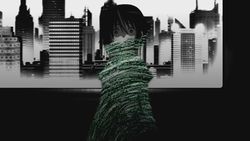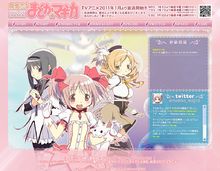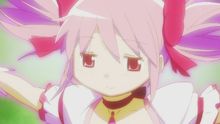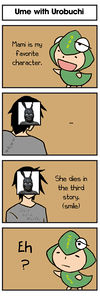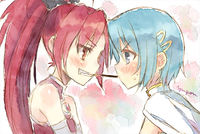Creative Intentions: Difference between revisions
m (todos) |
No edit summary |
||
| Line 200: | Line 200: | ||
|I wrote it in the afterword of “Fate/Zero” too. It was the time when I got so troubled by the fact that as much as I wanted to write a heartwarming story, somewhere in me just could not believe in legitimate happiness but I had to move the work to a happy end, and I almost wanted to hang up my pen. From very beginning, to opt for the individual instead of the world, to affirm his own desire and ambition is to me an absoulte bad-end. If the world should be destroyed then there was no salvation whatsoever left. I think in the past I just picked the escape route by landing the story in way that is a bad-end in a macro perspective but a happy-end from the individual's point of view. However, “Fate/Zero” is a story that had the individuals fallen into misfortune but got the world saved. Perhaps this became the turning point like you said and finally I could write my happy-end. After that, be it “Eisen Fluegel” or “Madoka”, I approached to write works in which the protagonist may face ruin and destruction but to the world it holds a good ending. | |I wrote it in the afterword of “Fate/Zero” too. It was the time when I got so troubled by the fact that as much as I wanted to write a heartwarming story, somewhere in me just could not believe in legitimate happiness but I had to move the work to a happy end, and I almost wanted to hang up my pen. From very beginning, to opt for the individual instead of the world, to affirm his own desire and ambition is to me an absoulte bad-end. If the world should be destroyed then there was no salvation whatsoever left. I think in the past I just picked the escape route by landing the story in way that is a bad-end in a macro perspective but a happy-end from the individual's point of view. However, “Fate/Zero” is a story that had the individuals fallen into misfortune but got the world saved. Perhaps this became the turning point like you said and finally I could write my happy-end. After that, be it “Eisen Fluegel” or “Madoka”, I approached to write works in which the protagonist may face ruin and destruction but to the world it holds a good ending. | ||
|} | |} | ||
[[Category:Production]] | |||
[[Category:Fanmade analysis]] | |||
Revision as of 02:14, 2 August 2011
This section may contain major spoilers!
Please refrain from reading if you are not yet familiar with all the latest media released.
This article contains speculation and analysis based on information from or about the creative staff. It serves as a speculation and observation section for Translated Official Documents as well as a place for analysis of story elements and the show's design based on the creative staff's intentions, methods, and history.
Thou Shalt Not Kill
| Megami Magazine | From an animation point of view, were there specific instructions from Shinbo or Inu Curry? |
|---|---|
| Yukihiro Miyamoto Series Director |
Shinbo would say something on the drawings on the layout and the situation design, like "I want here to be like this". But he did not say much about the personality of the characters. He only said "A character that killed other people cannot get a happy end". |
| Akiyuki Shinbo | In the anime, Sayaka didn't kill the two hosts. [Referring to the men she encountered on the train in Episode 8] |
|---|---|
| Gen Urobuchi | It can be interpreted as both ways in the scenario, so Hanokage-san interpreted it as if they're killed in her manga version. |
Madoka's world bears a strong sense of karma with regard to murder. The creators ensure that it does not go unpunished. Sayaka, who killed the two men on the train, could not escape her fate. Although the anime and manga disagree on whether she did so, under the "Schroedinger's Sayaka" principle, she must be treated as if she did in order to keep both interpretations viable. Even in Madoka's recreated world, she sacrifices herself and loses Kyousuke to Hitomi.
Ironically, the only magical girls who did not kill another magical girl before she became a witch were Kyouko and Sayaka, even though Kyouko and Sayaka attacked each other with intent to kill.
Since the other girls received relatively happy endings, there must be an exception applying in their cases. It may be that magical girls, being liches bound to soul gems, are already effectively dead and destroying them does not count as "killing other people." It is also possible that the rule is not absolute, and those who kill for the sake of protecting others are exempt from the consequences. Mami killed Kyouko to save her from becoming a witch, Homura killed Madoka for the same reason at Madoka's request, and Madoka killed Mami both to put Mami out of her misery and to save Homura's life. Another possible explanation is that this karma only applies to the same timeline the killing happened in.
| Translation Reliability |
|---|
| Since the "character that killed other people" quote relies on a single source and the original Japanese text (from an April Megami interview) is unidentified, it is possible that translation issues are interfering with interpretation of the quote. |
Chidamari Sketch
| Gen Urobuchi | It's disappointing that my new anime is called 'Chidamari (blood puddle) Sketch'." "I want to make the audience happy by the anime. |
|---|---|
| Gen Urobuchi | So here are my defendant's claims… Regarding the question "what's with that wholesome scenario writer?", in actuality, we had this idea of hiding the scenario writer's name until the broadcast started, but the plan failed since the staff list was leaked back in the early spring. But the director still wanted to surprise the viewers... So I thought it would be bad if everyone could guess how the series will be because of me. As a troubleshooter, I tried to mislead everyone. But as you can see, it's ineffective. Okay, that took a big load off my mind. Thank you everyone who kept up until today! I'm going back to the normal Urobuchi from now on! |
| Gen Urobuchi | If the “expectation” has a sense of direction, this is almost the same as “prediction”. And that is what I would like to disappoint if possible. The feeling for “I want to surprise them” is strong inside me. |
The production team conspired to hide the true nature of the work from fans and present it as a cute, happy mahou shoujo anime. They attempted to conceal Gen Urobuchi's involvement. The Teasers and Commercials advertizing the show, as well as the original website, were misleading.
Dedicated fans still uncovered the truth when the staff list was leaked in 2ch on April 1, 2010, and Urobuchi was identified as the writer. Viewers familiar with his visual novels wisely nicknamed the show "Chidamari Sketch" (Pool of Blood Sketch), suggesting that it would be a twisted and gory version of character designer Ume Aoki's Hidamari Sketch.
Urobuchi denied this and attempted to salvage the plan. When Episode 3 aired and Mami demonstrated that the show was headed into dark territory, Urobuchi admitted the truth and apologized for the deception. Some fans welcomed the new development, but others were still shocked like the production team had hoped.
In one notorious case, an Amazon user review gave the show a 1 star rating: "I recommended this to my niece over New Year's because of the cute character designs. Today I got an angry phone call from my sister and mother saying that she was frightened and depressed after watching the latest episode. I'm now banned from my parents' place. My niece won't speak to me. Everyone, be careful of the cute designs!" 97 out of 480 users found this review helpful, and there has been some debate over whether it was serious.
Healing-type Writing
| Gen Urobuchi | It's time to recognize me as a healing-type writer. |
|---|
Before Episode 3 aired, Urobuchi claimed on twitter that he had become a healing-type writer (iyashikei). This turned out to be rather misleading, and he later apologized for deceiving fans.
Upon reading the Fate/Zero Volume 1 Postface (copied below), "healing" takes on a new meaning. The postface indicates that one of Urobuchi's goals in writing Madoka was to explore how to write a happy ending within the confines of the logic and ruleset of a dark, unforgiving world. He took up the following challenge:
| Gen Urobuchi in Fate/zero vol. 1 postface |
Therefore, in order to write a perfect ending for a story you have to twist the laws of cause and effect, reverse black and white, and even possess a power to move in the opposite direction from the rule of the universe. Only a heavenly and chaste soul that can sing carols of praise towards humanity can save the story. To write a story with a perfect ending is a double challenge to the author's body and soul. Gen Urobuchi had lost that power. It still hasn't recovered. The 'tragedy syndrome' is still continuing within me. Is this a terminal disease? Should I give up on the pure 'warrior of love' that I've longed for? |
|---|
That turned out to be an exact blueprint for Madoka's ending. Madoka appears to be an attempt to overcome that "tragedy syndrome" by proving to himself that it's possible to have a self-consistent and natural happy ending to an Urobuchi story cruel enough to deserve the title "Chidamari Sketch" (Pool of Blood Sketch). In other words, this might be, in a way, a "healing" story, but from the author's perspective rather than the audience's.
Which Truth?
| Gen Urobuchi | To tell the truth, the production of the Madoka anime was temporary stopped once the scenario was finished, however Hanokage's manga still continued. So the rough sketch of the manga was done before the storyboard. It's amusing if you compare the manga and anime, as they're divergences from a single scenario |
|---|---|
| Gen Urobuchi | Main element of the story is how everyone from a different standpoint understands each other. |
| Akiyuki Shinbo | I did not want to show cruel scenes; I wanted to show the feeling of those people who had to face those situations. |
| Gen Urobuchi | ...Shinbo-san got attached to Sayaka and I got the request that “could something be done in the final episode to bring her back to life?”. For me, it was “That's enough.” (lol) In “Madoka” Sayaka is a character who would be a problem [to the story] if she was brought back to life... |
The story focuses on exploring how characters psychologically react to their circumstances, are shaped by their experiences, and come to understand one another (or fail to do so). The multiple timelines and storytelling techniques used show characters and events from several different perspectives and allow for various interpretations. As a result, the truth is sometimes ambiguous and dependent on one's point of view.
The anime and manga sometimes follow contradictory interpretations of the original scenario, as shown in Manga differences. Urobuchi intentionally left the issue of whether Sayaka killed the men on the train undecided. Doing so requires that the creators be careful to preserve "Schroedinger's Sayaka": Sayaka both did and did not kill the men, so all other aspects of the story must be compatible with both possible realities. According to Shinbo's rule that killers cannot receive happy endings, she must be punished, even though Shinbo himself believes she didn't kill.
This juggling act goes hand in hand with the effort to characterize the girls consistently across widely varying timelines. For example, Mami's behavior when dealing with Homura in the early episodes had to be written with her violent breakdown in Timeline 3 in mind. When she tried to intimidate Homura, was Mami on the verge of attempting murder, or was she just bluffing? Which did Homura believe? Which would the viewer believe on the first viewing, or upon rewatching after seeing Episode 10?
The dialogue and events of the first nine episodes appear very different when viewed through the lens of Homura's past. Lines that once seemed innocent turn into cruel mockery. By experiencing the same events from different points of view, the audience is better able to understand the characters' feelings and motivations.
Rather than simply writing characters off as "bad guys," viewers are forced to question their own assumptions about what they believe to be "the truth" when characters fight amongst themselves and behave badly for good reasons. The black-and-white worldview that divides most children's shows about magical heroes into good guys and bad guys is attacked both within and outside of the story. Sayaka attempts to follow that philosophy but fails miserably, and members of the audience who try to do the same will fare no better.
Design Check
| Ume Aoki on Mami |
Her twisty, curly hair and floral hairpin make her seem like a big sister. Also, I gave her pretty big boobs. Mami’s design was definiely centered around her image as a gunner. The second thing that stands out are her breasts. |
|---|---|
| Ume Aoki as apricot+ in RKGKMDK |
By the way, Homura-chan's normal clothes are the ones you see on the color page. I couldn't think of what she'd wear so I just let my lust guide me on that one. |
In order to maximize the contrast between the dark storyline and the bright, cute facade, even some of the show's staff were mislead into thinking they would be working on a normal mahou shoujo anime.
Ume Aoki, the artist famous for the heartwarming and happy Hidamari Sketch, was hired as the character designer. To ensure a convincing positive image, the true nature of the story was hidden from her until after the initial character designs had been completed. This unconventional tactic succeeded: Ume poured her heart into the design of her favorite Madoka character, Mami Tomoe, only to discover later that this masterpiece would be killed off in the third episode. Mami became exceptionally popular with fans.
| Emiri Katou Kyubey's Voice Actress |
I'd be happy if everyone stopped bullying Kyubey so much *tear*, okay? |
|---|
The voice actresses were also deceived. Kyubey's VA, Emiri Katou, believed she would be voicing a traditional, friendly, helpful magical mascot and attempted to present Kyubey in a sympathetic light until the bitter end.
Although Ume's work is usually thought of as pure and wholesome, the artist herself isn't quite so innocent. Several quotes reveal a fixation on Mami's boobs, and her Madoka doujin RKGKMDK features yuri shipping of her own characters and a revelation that lust served as inspiration. Perhaps this perspective allows her work to appeal to fans in certain ways without resorting to the out-of-character fanservice or undue pandering that is common in the anime industry.
Madoka has become very popular among yuri fans. See the Yuri undertones article for further details.
Considering various staff members' histories and unofficial artwork, there's little question that the story was designed to allow fans of yuri to enjoy such an interpretation. However, it has not been made explicitly canon, so the issue was most likely purposefully left open-ended, much like the question of whether Sayaka killed the men on the train. Those who wish to interpret the girls' relationships as simple friendships are able to do so.
Open-Ended End
Ending scenes, Homura, Kyouko, Mami's fates, mahou shoujo valhalla and manga afterlife scenes in oriko and PMMM, room left for season 2 while concluding the story.
break afterlife into a separate article: cover physical vs magical universes, madoka's transition from physical to magical side, qb's belief about fate of souls upon death and implications about closed box nature of physical universe as seen from within, manga and anime afterlife scenes, interactions between two universes - ghosts returning and conversion of physical closed box to open box as a means of using magic and countering entropy without actually breaking thermodynamics
Shinjidai_no_Mixture_Magazine_BLACK_PAST
4Gamer: We want to know more about what will happen to “Madoka Magika”. To be blunt, will it be a 2nd season?
Urobuchi: It would be great if we could have one.
4Gamer: Wow.... we surely wait in expectation! Does it mean that there is in fact some hidden advance hint in the last scene where Homura went to face the maju's in the wilderness?
Urobuchi: No, in fact I did not think of anything there. That was the result of various excessive overworks coming out from the staged animation (lol). In the screenplay, that scene was only put as “not in Japan”. As many have also observed, that is also a homage to “Blade”. The image was something like “The battle goes on... Homura, on to the world!”, and I was surprised that it generated all these researches. There is even a theory saying that “there is no doubt that she is the last surviving mahou shoujo!” and I think “Eh, what is that!?” (lol)
to do
-- Urobuchi – For me if I consider the “hidden history” in my life which had the impact of causing influence in my creation I remember when I was 24 I got sick and almost died. I contracted some epidemic and had fever. It got so dangerous that if the treatment had been delayed I could have died. What I could not forget is the feeling I had when I was in recuperation. Although I did not suffer grave wounds or anything like that, well, I felt that I was in a way erased from the society then. I could not get away from the feeling that I was just like a dead man. What I felt during that time is very much alive even now in my works.
Uno - So the fact that so often the protagonists got near death in your works is linked to that incident. And in every work you took care to build up a feeling that the body is slowly accumulating damages.
Urobuchi – By spending several months living like a dead man, I feel that I obtained something like the “eyesight of the dead”. It was unmistakably a precious experience when I could let my imagination to wander free regarding my death.
--
...to me it is nothing special at all that she could not come back to life, as this is also the future for the surviving mahou shoujo. Inside myself at the point of the final episode, whether she will be alive or she will be dead – the two are absolute equivalent. Whichever it will go, once the decision to become a mahou shoujo is made, those who were living at that point, like Homura or Kyouko or Mami or Sayaka, will all reach the same fate.
--
Urobuchi – That much is certainly true. For me, perhaps there is part in my thought that said whatever relationship that could exist between male and female it should also exist between couples of same sex. Inside me, I could not imagine a model in which there is something that absolutely could only exist between male and female. Notwithstanding the extra element of sex, I do not believe male-female relationship is such a special thing among all the different inter-human relationships. Therefore if I really feel like doing, I may even try a melodrama between male couples, something like BL.
Fate/Zero Volume 1 Postface
A translation of the postface by Gen Urobuchi is available here. In it, he discusses his history as a writer and his thoughts on writing endings.
Urobuchi commented on the relationship between his thoughts while writing Fate/Zero and Madoka in a Black Past interview.
| Uno (interviewer) | Among your works, even if we put side the issue of sexuality, it seems “Fate/Zero” is a turning point. Of the works before it, “Saya no Uta” is a good representative, where we can see a composition in which catharsis is obtained by means by giving priority to personal emotion over social mores when both are present. On the other hand, after “Fate/Zero”, the style is shifted to a direction in which the strength of the story was pulled up and tension was raised by continuously taking in concepts of morals and social responsibilities. The depiction of Kiritsugu Emiya in “Fate/Zero” is typical of this. |
|---|---|
| Gen Urobuchi | I wrote it in the afterword of “Fate/Zero” too. It was the time when I got so troubled by the fact that as much as I wanted to write a heartwarming story, somewhere in me just could not believe in legitimate happiness but I had to move the work to a happy end, and I almost wanted to hang up my pen. From very beginning, to opt for the individual instead of the world, to affirm his own desire and ambition is to me an absoulte bad-end. If the world should be destroyed then there was no salvation whatsoever left. I think in the past I just picked the escape route by landing the story in way that is a bad-end in a macro perspective but a happy-end from the individual's point of view. However, “Fate/Zero” is a story that had the individuals fallen into misfortune but got the world saved. Perhaps this became the turning point like you said and finally I could write my happy-end. After that, be it “Eisen Fluegel” or “Madoka”, I approached to write works in which the protagonist may face ruin and destruction but to the world it holds a good ending. |
